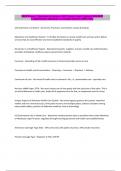IHOP Exam 1 | Questions & Answers (100 %Score) Latest Updated 2024/2025
Comprehensive Questions A+ Graded Answers | 100% Pass
Characteristics of a System - Structures, Processes, Connections, Inputs & Outputs
Objectives of a Healthcare System - To Enable all citizens to receive health care services and to deliver
services that are cost-effective and meet established standards of quality
Structures in a Healthcare System - Education/research, suppliers, insurers, health care administrators,
providers (individuals, facilities), payers, government, patients
Insurance - Spreading of risk, health insurance in America provides access to care
Processes in Health care & connections - Financing -> Insurance -> Payment -> Delivery
Continuum of care - the trend of health care in someone's life, i.e.. preventative care - specialty care
Harrison JAMA Paper 1974 - We must choose one of two goods with the exclusion of the other. This is
an ethical dilemma in health care, trade off of expensive care for few, or inexpensive care for many.
Unique Aspects of American Health Care System - No central agency governs the system, imperfect
market and non-universal access, third party insurers and multiple payers, balance of power among
many stake holders, practice of defensive medicine, love of technology
US Government role in health care - determine reimbursement rates to providers who render Medicare
or Medicaid, major financer, regulates through licensing personnel and health care establishments
Americans Coverage Type 2013 - 14% uninsured, 32% public insurance, 54% private insurance
Private Coverage Type - Employer is 91%, Self 9%
,Public Coverage Type - 6% other, 48% Medicaid, 46% Medicare
Why are people uninsured - They cannot afford to pay out of pocket, unemployed, not required to buy
insurance, employers do not offer insurance
Access to care in US is Limited to those - have health insurance via employer, covered by government,
can afford own insurance, can pay at time of service. Many providers do not accept Medicaid, issues
with getting care due to transportation etc.
Developed nations - ensure care for all citizens
Bismark model - Otto von bismark invented it in the 19th century, financed by sickness funds (non
profit), provided by private doctors, can opt out, but funds must cover everyone, tight government
regulations
The Out-Of-Pocket Model - The norm in most poor nations
National Health Insurance Model - Government Insurance that everyone pays into like in Canada
Beveridge Model - Named after William Beveridge, system provided and financed by government like in
Great Britain
Health care is shaped by - political climate, economic development, technological progress,
social/cultural values, physical environment, population characteristics, global influences
US Health Care System - Got there by accident, multiple payers, trying to fix it for decades, established
interests are really comfortable
Technology - Driving force that brought medicine into public domain, influenced by education, growth of
institutions, urban development, creating a professional entity, making medicine a growth enterprise
, Pre-Industrial Era - Medical practice in disarray, primitive medical procedures, missing institutional core,
hospitals were not good to go to, substandard medical education, unstable demand
Post Industrial Era 1900s - American physicians resisted national health care
Medicine Transformed in 1900s due to - urbanization, science and technology, industrialization, patient
dependency, cohesiveness and organization, licensing, educational reform
Urbanization - more people living in cities, centralized training and practice, women working outside of
home, house calls became office visits
Patients seen per day increase from 1850 - 1940 - 5- 7, 18-22
Science and Technology - ground breaking medical discoveries
Anesthesia - 1846
Aseptic Technique - 1847
Sterilization Technique - 1860
X-ray Imaging - 1895
Antibiotics - Penicillin - 1929
Cultural Authority - legitimized the profession
Institutionalization - pooling of resources, professionalization, urbanization
Hospitals - became institutions of core care delivery




